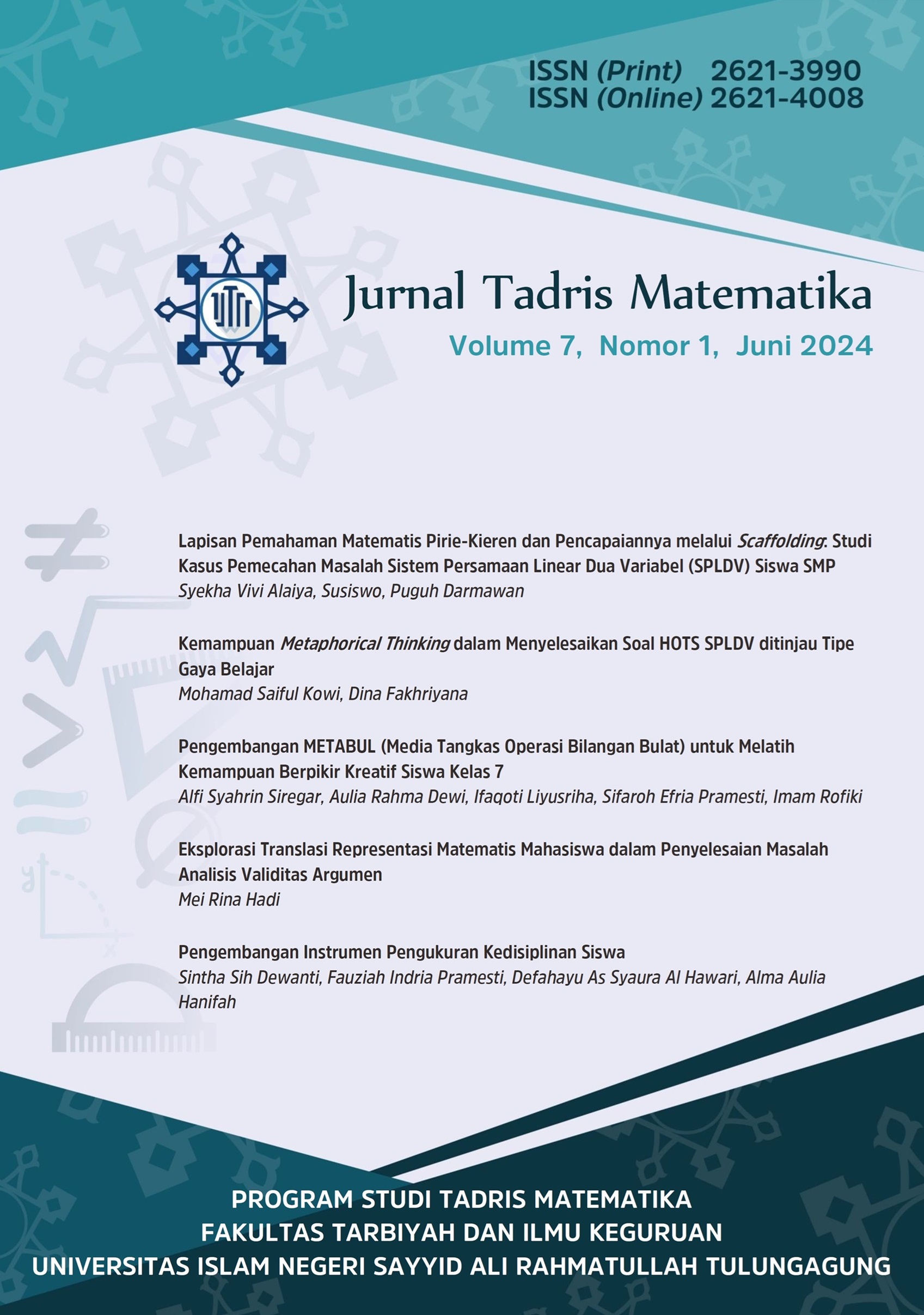Abstract
The ability to translate among mathematical representations is one of the 21st-century skills that students need to have. This ability is often challenging for students, especially in translating verbal to symbolic or visual forms. One of the materials that requires translation skills is argument validity analysis. This study aims to explore the mathematical translation process of students use in completing argument validity analysis. This study is a qualitative study with an exploratory approach. The subjects of the study were 3 Mathematics Education students who were selected through purposive sampling and analyzed in depth using Polya's problem-solving stages and Bosse's translation process. The results showed that the problem-solving process went hand in hand with mathematical translation activities. Subjects who carried out the mathematical translation process correctly and completely tended to solve problems better. Subjects made several mistakes in the translation process, including misinterpretation and implementation errors that resulted in inaccurate argument validity analysis. These findings indicate that mathematical translation skills are an important basis for solving argument validity analysis problems. Therefore, learning strategies that support the improvement of mathematical translation skills need to be developed to strengthen students' critical thinking skills in analyzing the validity of arguments at the higher education level.
References
Agusfianuddin, Herman, T., & Turmudi. (2024). Difficulties in mathematical language and representation among elementary school students when solving word problems. Jurnal Elemen, 10(3), 567-581. https://doi.org/10.29408/jel.v10i3.25814
Ainsworth, S. (2006) DeFT: A conceptual framework for considering learning with multiple representations. Learning and Instruction, 16(3). https://doi.org/10.1016/j.learninstruc.2006.03.001
Bosse, M. J., Adu-Gyamfi, K., & Chandler, K. (2014). Students’ differentiated translation processes. International Journal for Mathematics Teaching and Learning. Retrived from: https://www.cimt.org.uk/journal/bosse5.pdf
Bossé, M. J., Adu-Gyamfi, K., & Cheetham, M. R. (2011). Assessing the Difficulty of Mathematical Translations: Synthesizing the Literature and Novel Findings. International Electronic Journal of Mathematics Education, 6(3), 113-133 https://doi.org/10.29333/iejme/264
Bosse, M., Bayaga, A., Fountain, C., Young, E. (2019). Mathematical representational code switching. International Journal for Mathematics Teaching and Learning, 20(1). 33-61. http://dx.doi.org/10.4256/ijmtl.v20i1.141
Duval, R. (2006). A cognitive analysis of problems of comprehension in a learning of mathematics. Educational Studies in Mathematics, 61(1-2), 103-131. http://dx.doi.org/10.1007/s10649-006-0400-z
Goldin, G. A., & Kaput, J. J. (2019). A Framework for Representations in Mathematical Problem Solving and Learning. Springer
Hanna, G., Knipping C. (2020) Proof in Mathematics Education, 1980-2020: An Overview. Journal of Educational Research in Mathematics. 2020, Special Issue, 001 ~ 013. Retrieved from: https://www.researchgate.net/publication/344566063
Janvier, C. (1987). Problems of representation in the teaching and learning of mathematics. Lawrence Erlbaum Associates, Inc.
Lin, S.-Y., Maries, A., & Singh, C. (2016). Student difficulties in translating between mathematical and graphical representations in introductory physics. Physics Education Research Conference. https://doi.org/10.48550/arXiv.1601.05466
Mahmud, M. & Wong, S. F. (2022). Digital age: The importance of 21st century skills among the undergraduates. Frontiers in Education, 7(950553). https://doi.org/10.3389/feduc.2022.950553
Mainali, B. (2021). Representation in teaching and learning mathematics. International Journal of Education in Mathematics, Science, and Technology (IJEMST), 9(1), 1-21. https://doi.org/10.46328/ijemst.1111
Mardhiyah, R.H., Aldriani, S. N. F., Chitta, F. (2021). Pentingnya keterampilan belajar di abad 21 sebagai tuntutan dalam pengembangan sumber daya manusia. Lectura: Jurnal Pendidikan, 12(1). https://doi.org/10.31849/lectura.v12i1.5813
Munfaridah, N., Avraamidou, L., & Goedhart, M. (2021). The use of multiple representations in undergraduate physics education: What do we know and where do we go from here? Eurasia Journal of Mathematics, Science and Technology Education, 17(1), https://doi.org/10.29333/ejmste/9577
Nurrahmawati, Sa'dijah, C., Sudirman, Muksar M. (2021). Assessing students’ errors in mathematical translation: From symbolic to verbal and graphic representations. International Journal of Evaluation and Research in Education (IJERE), 10(1). http://doi.org/10.11591/ijere.v10i1.20819
Oser, F.K., Biedermann, H. (2019). A three-level model for critical thinking: critical alertness, critical reflection, and critical analysis. Frontiers and Advances in Positive Learning in the Age of InformaTiOn (PLATO) p. 89-106. https://doi.org/10.1007/978-3-030-26578-6_7
Park, J. H., Niu, W., Cheng, L., Allen, H. (2021). Fostering creativity and critical thinking in college: A cross-cultural investigation. Frontiers in Psychology, 12. http://dx.doi.org/10.3389/fpsyg.2021.760351
Polya, G. (1985). How to Solve It 2nd ed Princeton. University Press: New Jersey
Rahmah, F., Subanji, Irawati, S. Mathematical representation analysis of students in solving mathematics problems. Journal of Physics: Conference Series, Volume 1200, 5th International Symposium on Mathematics Education and Innovation (ISMEI) 13–14 November 2018, Yogyakarta, Indonesia. Retrived from: https://iopscience.iop.org/article/10.1088/1742-6596/1200/1/012011/pdf
Rahmawati, D., Purwanto, Subanji, Hidayanto, E., & Anwar, R. B. (2017). Process of mathematical representation translation from verbal into graphic. International Electronic Journal of Mathematics Education, 12(3), 367-381. https://doi.org/10.29333/iejme/618
Saha, M., Islam, S., Akhi, A., & Saha, G. (2022). Factors affecting success and failure in higher education mathematics: Students and teachers’ perspectives. Heliyon, 10(7). http://dx.doi.org/10.20944/preprints202209.0378.v1
Sa’dijah, C. Afriyani, D. Subanji, Muksar, M., & Anwar, L. (2018). Assessing students’ pseudo-mathematical translation using translation-verivication model. AIP Conf. Proc. 21 September 2018; 2014 (1): 020144. https://doi.org/10.1063/1.5054548
Samijo, S., Santia, I., & Jatmiko, J. (2023). Analisis kesalahan translasi matematis dari representasi verbal menuju representasi simbolik. PTK: Jurnal Tindakan Kelas, 4(1), 192–202. https://doi.org/10.53624/ptk.v4i1.312
Santia, I., Purwanto, Sutawidjadja, A., Sudirman, Subanji. (2019). Exploring mathematical representations in solving ill-structured problems: The case of quadratic function. Journal on Mathematics Education, 10(3)
Shavelson, R. J., Zlatkin-Troitschanskaia, O., Beck, K., Schmidt, S., & Marino, J.P. (2019). Assessment of university students’ critical thinking: Next generation performance assessment. International Journal of Testing, 19(1) 1-20. http://dx.doi.org/10.1080/15305058.2018.1543309
Stylianides, G.J., Stylianides, A.J., Moutsios-Rentzos, A. (2024). Proof and proving in school and university mathematics education research: A systematic review. ZDM Mathematics Education, 56(2), 47–59. https://doi.org/10.1007/s11858-023-01518-y
Yuanita P., Zulnaidi H., Zakaria, E. (2018). The effectiveness of realistic mathematics education approach: The role of mathematical representation as mediator between mathematical belief and problem solving. PLOS ONE, 13(9). https://doi.org/10.1371/journal.pone.0204847

This work is licensed under a Creative Commons Attribution-ShareAlike 4.0 International License.

